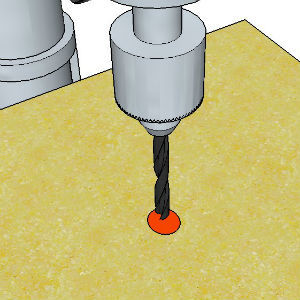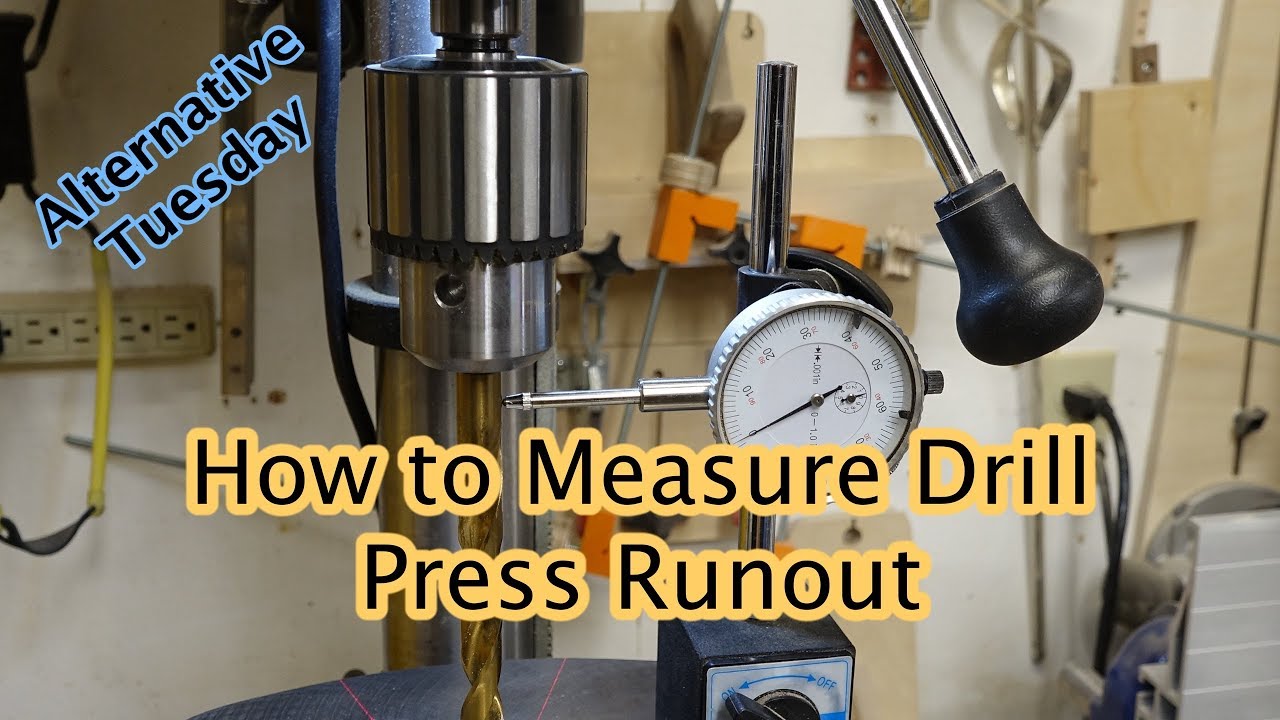So, you want to know what runout on a drill press is? Well, you’ve come to the right place! In simple terms, runout refers to the wobbling or deviation of a drill bit as it spins on the drill press. It’s like the wobble you see in a spinning top when it’s not perfectly balanced.
You might be wondering why runout is important. Well, when the drill bit wobbles, it can affect the accuracy and precision of your drilling. It can result in holes that are off-center or not properly aligned, which can be a real headache, especially if you’re working on a precise woodworking or metalworking project.
But don’t worry, there are ways to minimize runout and ensure your drill press performs at its best. In the upcoming sections, we’ll explore the causes of runout and provide you with practical tips to reduce it, so you can achieve accurate and precise drilling every time.
So, let’s dive in and demystify runout together! By the end of this article, you’ll have a clear understanding of what it is and how to tackle it like a pro. Let’s get started!
- Inspect the chuck and ensure it is clean and free from debris.
- Check the drill bit for any damage or signs of wear.
- Mount the bit securely in the chuck, ensuring it is centered.
- Tighten the chuck firmly without over-tightening.
- Ensure the drill press is properly calibrated for accuracy.
By following these steps, you can reduce runout and achieve precise drilling results with your drill press.

What is Runout on a Drill Press?
When it comes to using a drill press, understanding the concept of runout is crucial. Whether you’re a beginner or an experienced woodworker, knowing what runout is and how it affects your drilling operations can greatly enhance the quality and precision of your work. In this article, we will delve into the world of runout and explore its significance in the context of a drill press.
The Importance of Runout on a Drill Press
Runout refers to the amount of wobbling or deviation in the rotation of the drill bit on a drill press. In other words, it measures how much the bit moves off-center as it spins. If a drill press has high runout, it means the drill bit is not rotating perfectly aligned with the spindle, resulting in inaccurate and imprecise holes. Runout can affect the performance of your drill press in several ways, including:
- Reduced Accuracy: A drill press with high runout will produce holes that are not perfectly perpendicular to the surface, leading to inaccuracies in measurements and misalignment with other components.
- Poor Finish: When the drill bit wobbles during drilling, it can cause splintering or rough edges on the material being drilled, resulting in a poor finish.
- Increased Bit Wear: High runout can cause excessive wear on the cutting edges of the drill bit, leading to decreased tool life and the need for more frequent replacements.
How to Measure Runout on a Drill Press
Now that we understand the importance of runout, let’s explore how to measure it on a drill press. To measure runout, you’ll need a dial indicator and a magnetic base. Follow these steps:
- Secure the magnetic base to the drill press table or spindle housing.
- Mount the dial indicator on the magnetic base, ensuring that the indicator tip is in contact with the drill chuck or the arbor for maximum accuracy.
- Rotate the chuck by hand and observe the readings on the dial indicator. The runout is the difference between the maximum and minimum readings. Ideally, the runout should be within 0.003 inches or less for most drilling applications.
If you discover that your drill press has excessive runout, there are a few possible causes:
- Worn Chuck or Arbor: Over time, the chuck or arbor can become worn or damaged, causing increased runout. In such cases, replacing the chuck or arbor may be necessary.
- Loose Quill: A loose quill can result in excessive runout. Ensure that the quill is properly tightened and secure before use.
- Improper Spindle Alignment: If the spindle is not properly aligned, it can contribute to higher runout. Consult your drill press manual for instructions on how to realign the spindle, or seek professional assistance if needed.
The Benefits of Minimizing Runout
Minimizing runout on your drill press can have several benefits:
- Improved Accuracy: By reducing runout, you can achieve greater accuracy in your drilling operations, resulting in precise holes and properly aligned components.
- Enhanced Finish: With reduced runout, the chance of splintering or rough surfaces decreases, leading to a smoother and more professional finish.
- Extended Tool Life: Lower runout means less wear on your drill bits, resulting in increased tool life and reduced replacement costs.
Conclusion
Understanding runout and its impact on your drill press is essential for achieving accuracy and precision in your woodworking projects. By measuring and minimizing runout, you can enhance the performance of your drill press, improve the quality of your work, and save time and money in the long run. Remember to regularly check and maintain your drill press to ensure optimal performance, and don’t hesitate to seek professional help if needed. Happy drilling!
Key Takeaways: What Is Runout on a Drill Press?
- Runout refers to the amount of wobbling or deviation in the drill bit when it spins.
- Runout can affect the accuracy and quality of your drilling results.
- It is important to minimize runout for precise drilling.
- Runout can be caused by factors like worn-out bearings, misaligned parts, or low-quality drill bits.
- Regular maintenance and using high-quality drill bits can help reduce runout on a drill press.
Frequently Asked Questions
Do you want to know more about runout on a drill press? Look no further! We’ve compiled some common questions and their answers to help you understand this concept better.
Why is runout important to consider when using a drill press?
Runout is an important factor to consider because it affects the accuracy and precision of your drilling. When a drill press has runout, it means that the drill bit doesn’t spin perfectly concentric with the axis of rotation. This can result in holes that are not perfectly round or straight, leading to subpar results in your projects. By paying attention to runout, you can ensure that your drilling is precise and your projects turn out the way you want them to.
Furthermore, runout can cause excessive vibrations, which can be dangerous and affect the longevity of your drill press. It can lead to premature wear and tear on the machine, affecting its performance and potentially causing damage. By understanding runout and taking steps to minimize it, you can improve the overall efficiency and lifespan of your drill press.
How can I check for runout on my drill press?
To check for runout on your drill press, you can use a dial indicator. Attach the dial indicator to the chuck and position it near the edge of a fixed surface, such as a table or column. Slowly rotate the chuck and observe the movement of the dial indicator. If the needle fluctuates more than an acceptable range, you have runout.
If you don’t have a dial indicator, you can use a simple method using a cylindrical rod or dowel. Secure the rod or dowel in the drill chuck and position it near a fixed surface. Slowly rotate the chuck while observing the gap between the rod and the surface. If the gap fluctuates significantly, there is runout present.
What causes runout on a drill press?
Various factors can cause runout on a drill press. One common cause is a misaligned or worn-out chuck. If the jaws of the chuck don’t grip the drill bit evenly, it can result in runout. Additionally, if the chuck or spindle is damaged or has excessive play, it can contribute to runout.
Another factor that can cause runout is a bent or worn-out drill bit. If the bit is not straight, it will introduce runout when used with the drill press. It’s essential to regularly inspect and replace worn-out or damaged drill bits to minimize runout.
Can runout be fixed on a drill press?
While it may not be possible to completely eliminate runout, there are steps you can take to minimize it. Start by ensuring that you have a quality drill press with minimal play in the chuck and spindle. Regularly maintain and inspect your drill press to address any issues that may contribute to runout.
When changing drill bits, make sure they are straight and not worn-out. A new, high-quality bit can significantly reduce runout compared to a bent or worn-out one. Additionally, using a drill press with a lower runout rating can help improve precision and minimize runout.
Are there any precautions I can take to prevent runout on a drill press?
Absolutely! Here are a few precautions you can take to prevent runout on your drill press:
- Always use sharp and straight drill bits to minimize runout.
- Securely tighten the chuck to ensure even gripping of the drill bit.
- Regularly inspect and maintain your drill press, addressing any issues promptly.
- Use a lower runout-rated drill press for more precise drilling.
- Avoid excessive lateral pressure when drilling as it can contribute to runout.
By implementing these precautions, you can significantly minimize runout on your drill press and achieve accurate and precise drilling results.

Summary
So, what is runout on a drill press? Simply put, runout refers to the wobbling or movement of the drill bit when it spins. This can cause inaccuracies and affect the quality of your drilling. It’s important to minimize runout for precise and efficient drilling. One way to do this is by using a good quality drill press with minimal runout. Another is to properly secure the workpiece and ensure the drill bit is securely tightened. By taking these steps, you can improve the accuracy and effectiveness of your drilling projects. So, happy drilling!
